Today Central Park is an 843-acre oasis in Manhattan stretching from 59th Street to 110th Street between 5th and 8th Avenues. But in 1858 when the Frederick Law Olmsted and Calvin Vaux Greensward Plan won the competition for creating Central Park the designated area was a barren landscape with interspersed shanties and squatters and the site of one small village.
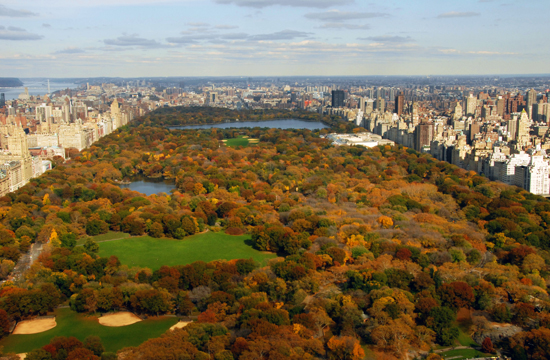
In 1840, the vast majority of the 300,000 New Yorkers lived south of 14th Street. At this time sanitation was almost nonexistent. The discarded materials of daily life and the wastes of animals both dead and alive in this horse-powered society were everywhere. However, there was a nascent recycling industry representing a range of livelihoods from rag pickers to offal boilers who rendered animal byproducts to make feed for livestock.
A number of businesses in pre-Central Park area were called 'nuisance industries' according to a Columbia University project (1) that investigated the early inhabitants of the land that was to become Central Park. These businesses: "... included soap and candle factories, which used offensive chemicals and emitted bad odors, and a bone-boiling plant that used the animal carcasses to make oil that was used in refining sugar, as well as in making glue. The park communities were portrayed as disease-ridden shantytowns inhabited by 'tramps,' 'squatters,' and 'thieves' -- the lowest rungs of society -- who lived in dilapidated shacks surrounded by pigs, sheep, and cows. Residents and property owners were ordered to vacate the park area by August 1, 1856" (1). Similarly, in ridding the proposed Park area of structures prior, the Committee on Buildings in the Park noted in their 1857 report: "Some of the buildings are also occupied as foundries, rope walks, bone-burning establishments, etc. These generally are a nuisance; and by the number and class of persons who are employed in them, are more likely to be sources of annoyance and loss, than of profit."(2)
... the low grounds were steeped in [the] overflow and mash of pig sites,
slaughterhouses and bone boiling works and the stench was sickening
Frederick Law Olmsted during an 1856 tour of pre-Central Park (3)
The Columbia University project notes the use of bone boiling oil in the refinement of sugar. However, no other mention of this usage was found. It was not the bone-boiling oil, but the boiled bones themselves that were an important component of sugar refining and other industries during this time period. The residue, primarily grease, from bone boiling was used in soap production (4) and the bones were considered a valuable commodity: the best used for handles and buttons and the next best were ground and pyrolyzed to be used by sugar refiners (5).

Historical Map of Central Park, New York City
The first known use on bone char (also called bone black or animal char) as a method to clarify sugar was an 1815 United Kingdom patent by Peter and John Martineau. They found bone char to be preferable to all other materials tested (6). Hastilow in an article on sugar refining states: "It will probably be the most convenient introduction to this paper if I describe in broad outline the manner in which bone char is used in a sugar refinery... Bone char is used for removing colour and ash from refinery brown liquor to give fine liquor, which is the primary feed to the fine sugar vacuum pans" (7). Further, Hastilow concludes that: "No paper dealing with bone char could conclude more fittingly than by quoting verbatim from Oliver Lyle's book-Technology for Sugar Refinery Workers: Bone Charcoal, or 'Char', as we call it, is a sugar refining material quite unequalled by anything else. There are bleaching processes that remove, often temporarily, the colour from coloured solutions. There are vegetable carbons that remove the colour entirely. But there is no other material which removes the colour and removes quite a lot of ash as well which is moderate in price, which lasts for many years, and which stands up to rough treatment without rapid loss of efficiency" (7).
Lyle further states that the char 'is made by heating bones from which grease has been removed, in a closed retort at a cherry red heat until all the volatile matters have been driven off" (8). He then illustrates the need for bone boiling to de-grease the bones and the emission of odorous volatiles from the charring process. Unfortunately no diagram or detailed descriptions of the bone boiling and charring operations in pre-Central Park were found but it is evident that boiling bones in cauldrons would remove the grease and the technology for charring bones using retort kilns, long used in the production of wood charcoal, has been available. Mapes (9) describes a grinding mill for plaster, bones, etc. suitable for individual farmers in 1850.
In 1858 the Havemeyer & Elder Refinery settled on the Brooklyn waterfront. In 1872 they became the leader in the sugar refinery industry. In 1883 the refineries were producing three million pounds of sugar or 1.4 million kilos of sugar a day needing app. 3 t of bone char per day. (photo: domino sugar factory)
How much char was needed for sugar refining? An 1846 report from London on The Useful Arts and Manufactures of Great Britain (10) notes that chemists had discovered the existence of a remarkable attraction between animal charcoal and the coloring compounds in animal or vegetable material and describes its use in sugar refining. The animal charcoal (bone-black or bone-charcoal) was produced by heating bones to redness in a close vessel, or when covered over by sand. The charred bones were then pounded in a mill into a coarse granular state like gunpowder. For sugar refining, oblong vessels containing about three feet of animal charcoal are used to process the reddish brown sugar liquor. The liquor flows in a gentle stream over the surface gradually losing its color, until it arrives at the bottom, when it is colorless. The filtered liquor is then pumped to the sugar boilers. The original bone char patent in 1815 by Peter and John Martineau called for the use of 2 to 5 pounds of char per 100 pounds of sugar (6). As the clarification process was enhanced and the scale of production increased so did the amount of char: from 10,000 pounds in 1900 vintage filters (11) to 1,000 to 2,000 cubic feet capacity char filter cylindrical vessels (12).
Sugar refining was a big industry in early New York. Rhinelander Sugar House was established in 1763 in lower Manhattan and probably used ox-blood, clay and albumen as clarifying agents (13). William and Frederick Havemeyer from England established a sugar refinery in 1805 and by 1860 there were 39 sugar refineries in the United States and 18 of which were in New York. Correspondingly, per capita sugar consumption increased from 16 pounds in 1840 to 39 pounds in 1862. However, by 1860 most of the sugar refining had moved from Manhattan Island to the waterfront of Brooklyn when Henry Havemeyer consolidated a number of New York refineries into the Sugar Refining Company in 1887, later home of the Domino® sugar brand, which produced almost all United States sugar. The refining process by then was using bone char filtering exclusively (14). Dunlap (15), writing about the New York City Domino® sugar refinery, noted that "...much of the sugar arriving at the Havemeyer family's refinery on the Williamsburg waterfront had been harvested by slaves. It was mixed into a dirty slurry, boiled in enormous vats and filtered through charred animal bones."
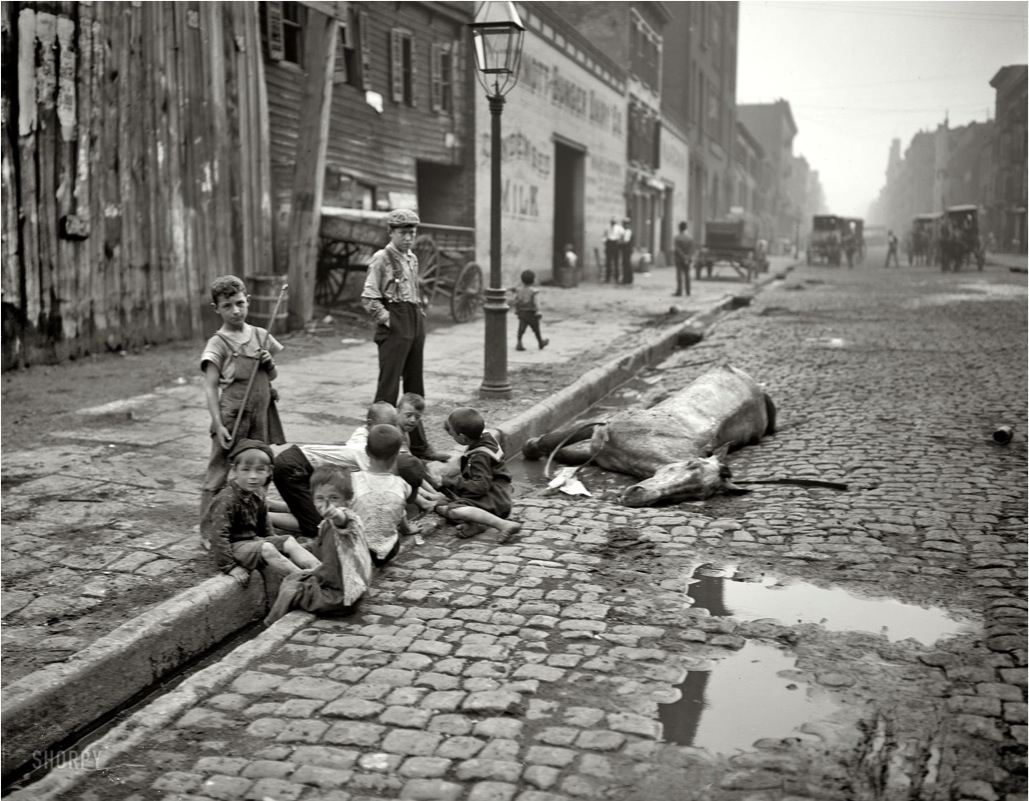
100 years before the iPhone kids would stroll along Broadway, children hoped to obtain a buck for the bones of a dead horse.
How many bone-boiling plants were within the area of the proposed Central Park? Rosenzweig and Blackmar (16) mention two bone-boiling plants: "There were economical uses for refuse that could not be recycled for human consumption: unused garbage fed the pigs and goats that some park dwellers raised; the bones of dead animals fueled the two bone-boiling plants located at 66th and 75th streets, a short walk south of Seneca Village". Seneca Village existed in pre-Central Park from 1825-1857. It was the first significant community of African American property owners in Manhattan. " More specifics on the southern bone-boiling plant include "... On the western side of the park were the bone-boiling plants of George Moller and William Menck. Such 'nuisance' industries were being driven out of lower Manhattan by ordinances, restrictive covenants, and public pressure. ... Some park dwellers helped to gather the thirty-four thousand bushels of animal bones that Moller and Menck required each year (as 1 bushel is 50 lbs, 34,000 bushels of bones equates to ~850 tons of bones annually); others found the dollar-a-day wages offered at the plants attractive; and the rest were willing to tolerate (or at least lacked the resources to complain about) the noxious odors released when bones were boiled to produce fuel for sugar refining.
Additional information about George Moller and his bone-boiling plant was included on GenForum posts: Based on 1855 census, George Moller was a property owner. His property (bone boiling plant) at West 74-75 Streets and Central Park West was bought by the City of New York for development of Central Park. The Moller family likely lived slightly north at around West 77th Street, just east of Central Park West in dwelling #204, a large frame house, $2000 value. The owner, George H Moller, was 37 years old, from Germany whose occupation was animal charcoal. According to the 1870 United States Federal Census a William Menck resided in district 20 in New York City and was a manufacturer of charcoal." (17)
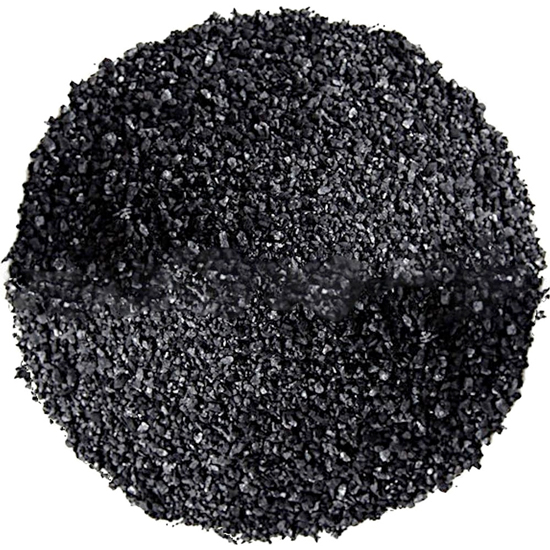
Bone char looks as black as any biochar though it contains only about 10% carbon with up to 80% phosphate.
Speculation is that the two bone boiling plants in pre-Central Park were also charring bones since there was a ready market for the bone char in sugar refining. There would be little return to use bones solely to boil more bones even though the grease was used for soap and candles. Since the two bone boiling plants were processing about 850 tons of bone annually one can certainly envision that at least two bone yards existed in pre-Central Park. Over time these operations moved further away from the expanding city but carried along with them the 'nuisance' tag. By 1865 one such report was recorded for South Brother Island that lies in the East River of New York. Bone boiling operations were set up and soon steamboat passengers renamed the island "Stink Island" (18).
Today bone char is still produced and although its use in sugar refining is decreasing other uses such as a soil amendment, water treatment or pigments are more current. Two of the many industrial entities that currently produce bone char are Ebonex Corporation in the United States and 3R Agrocarbon in Europe. Apart from the 5 to 10% of aromatic carbon, bone char has a very high phosphate and calcium content (60 to 80% tricalcium phosphate) and it is increasingly recommended as an organic phosphate fertilizer. Although its production process is the same as for biochar, the low carbon content would not allow it to be considered as biochar. However, in farm scale biochar production with the Kon-Tiki flame curtain pyrolysis (19), bones are sometimes blended at 10 – 20 % to carbon rich biomass feedstock like wood waste or crop residues increasing thus the fertilizing phosphate content of biochar. If such a bone phosphate enriched biochar is quenched with N and K rich urine, the resulting biochar based organic fertilizer can be considered and used as complete NPK fertilizer.
This age old technique has even made it to outer space as bone char is used in spacecraft design as final layer for foil heat shielding...
References
1. Columbia University. A Park, a Park, Anywhere a Park. 1995.
http://projects.ilt.columbia.edu/seneca/03park1.html
2. New York City Parks Department Annual Reports. 1857-58. Documents of the Board of Commissioners of Central Park, Document No. 3, May 26, 1857. Report by the Committee on Buildings in the Park. pp 16-90.
3. McNeur, Catherine. Taming Manhattan Environmental Battles in the Antebellum City. 2014. Harvard University Press, Cambridge. p. 161.
4. Rosenzweig, Roy and Elizabeth Blackmar. 2003. Pig Keepers, the Story of Bone Boilers, and Central Park. Humanities Nov/Dec 2003, Vol. 24, Issue 6, pp 22-25.
5. Miller, Benjamin. 2000. Fat of the Land – Garbage in New York the Last Two Hundred Years. Four Walls Eight Windows, New York. p 40.
6. Niccol. Robert. 1864. Essay on sugar, and general treatise on sugar refining as practised in the Clyde refineries; with notes. Mackenzie & Co. Greenock, UK. p 29.
7. Hastilow, D. Bone Char in Sugar Refining Its Use and Testing. 1957. http://www.sasta.co.za/wp-content/uploads/Proceedings/1950s/1957_Hastilow_Bone%20Char%20In%20Sugar.pdf
8. Lyle, Oliver. 1941. Technology for Sugar Refinery Workers. Chapman and Hall Ltd., London. p 258.
9. Mapes. James J. 1850. Grinding of Plaster, Bones, etc. Working Farmer, Kingman & Cross, Clinton Hill, New York. p 13.
10. Mawer, Bryan (website compiler). 1846. The Useful Arts of Manufactures. The Manufacture of Sugar Extract. London. http://home.clara.net/mawer/intro.html
11. Vogt, Paul L. 1908. The Sugar Refining Industry in the United States – Its Development and Present Condition. University of Pennsylvania, PA.
12. Bradford, C. F. and J. A. B. Ball. 1925. The Elements of Sugar Refining. The Chemical Publishing Company, Easton, PA.
13. Mescher, Virginia. 2005. "How Sweet It Is" A History of Sugar and Sugar Refining in the United States Including a Glossary of Sweeteners. pp 2-7. www.raggedsoldier.com/sugar_history.pdf
14. American Sugar Refining Company. 1918. A Century of Sugar Refining in the United States 1816-1916. 3rd edition. The DeVinne Press, NY.
15. Dunlap, David W. October 23, 2013. Relics of the Domino Sugar Refinery, Frozen in Time and Syrup, New York Times http://www.nytimes.com/2013/10/24/nyregion/sticky-relics-of-the-domino-sugar-refinery.html
16. Rosenzweig, Roy and Elizabeth Blackmar. 1992. The Park and the People: A History of Central Park. http://books.google.com/books?isbn=0801497515
17. http://genforum.genealogy.com/moller/messages/58.html, accessed 30th October 20 15
18. New York Times. 1865. The Bone-Boiling Nuisance. Letter to the Editor. http://www.nytimes.com/1865/09/09/news/the-bone-boiling-nuisance.html
19. Schmidt, H.; Pandit, B.; Martinsen, V.; Cornelissen, G.; Conte, P.; Kammann, C. Fourfold Increase in Pumpkin Yield in Response to Low-Dosage Root Zone Application of Urine-Enhanced Biochar to a Fertile Tropical Soil. Agriculture 2015, 5, 723–741.

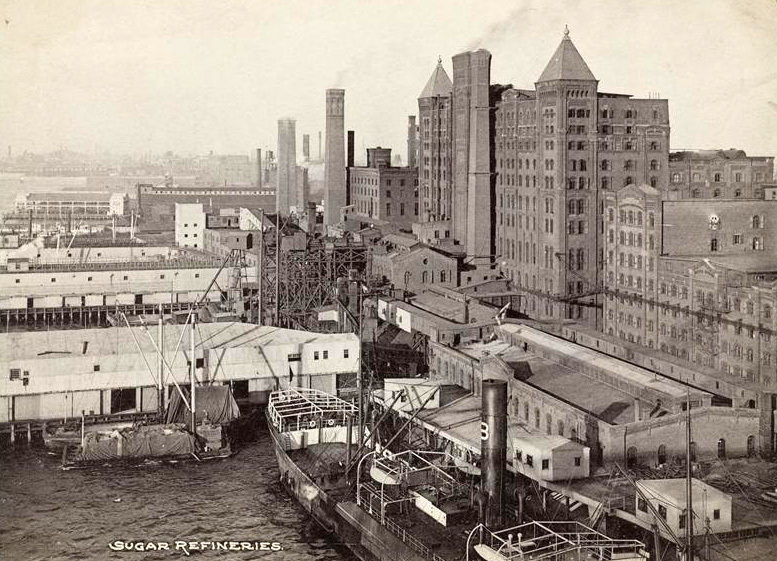
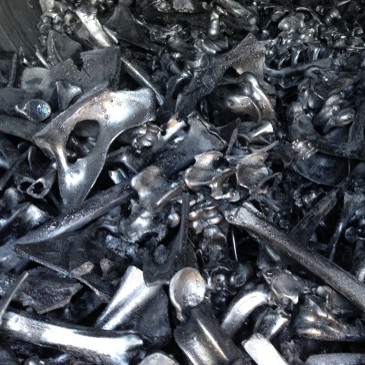
Excellent historical review
Another great article from the Biochar Journal! The first image caught my eye in the email even before the article title, as it looked like one of mine of pyrolized deer bones made last year during our deer season in southeast Ohio. I used an Exeter Charcoal Retort for processing, and we're gearing up again this winter to process more deer bones that would otherwise be landfilled, and are also expanding into cow bones. The Callicrate Cattle Company out in western Kansas also uses an Exeter for producing bone char. Anyone interested in learning more about our process can get in touch via our website, http://www.exeterrallc.com. Thanks again for the excellent article, it's great to learn more about the history.